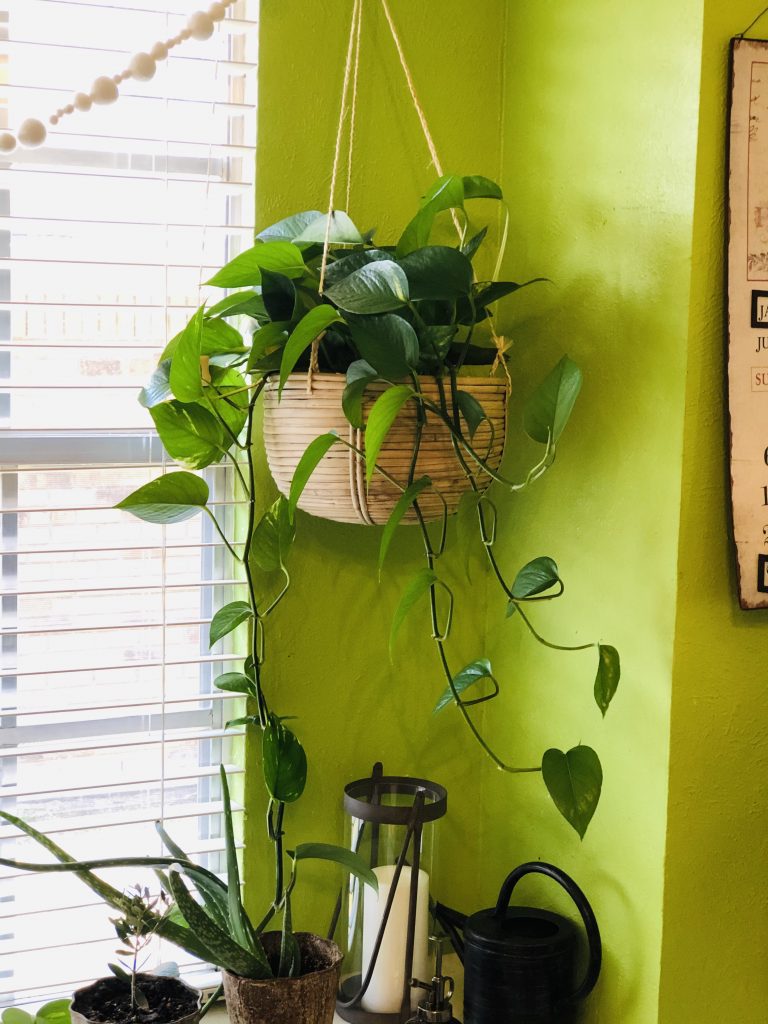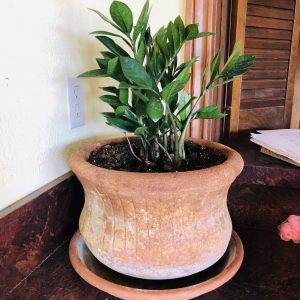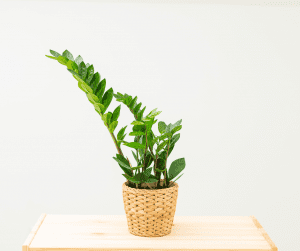
- Snake Plant: Keep this plant in a container in bright, indirect light (no sun shining directly on this one). Do not over water; if the first two inches of soil are dry, that’s watering day.
- Rosemary: Start with seeds or cuttings and plant outdoors in full sun, being careful not to over water. The herb can grow into a shrub, but just prune it back and take cuttings regularly. I naively scattered some seeds in a raised garden bed in 2015, and now have an enormous rosemary bush in my backyard. My backyard faces the south and gets a TON of heat.
- Heart-Leaf Philodendron: This plant looks great in a hanging basket. Mist it often, since it likes a humid environment. Water when the top 50-75% of the soil is dry. Per the picture, this plant hangs by a window in my house that gets indirect southwest light.

- Aloe Vera: Put this plant on a sunny window ledge and do NOT over water. Treat it like a succulent. Only water when the soil is completely dry. My aloe vera is on a windowsill that gets bright light from the southwest.
- ZZ Plant: For the most forgetful plant owner…only water when the soil is completely dry. It can tolerate low light and doesn’t need misting. This plant gets indirect light from the south at my house.

How to buy an indoor plant & not kill it
- Buy one plant. Just one. Make sure to get one with the plant’s description and care tag attached.
- Read the care tag. Ask someone or look up the plant if you are unsure what it’s talking about. Let the store know if you are new to this; they like to help.
- Do not pot the plant.
- Based on the care tag, place the plant in the room that meets its requirements for light.
- Tell the plant that this is its new home, and you are its parent.
- Water your plant in the sink with lukewarm water until the water is dripping from the bottom of the plant’s carton.
- Stop watering. Place the plant in the sink for a few minutes to let it dry slightly.
- Put the plant back in the room where you want it to live.
- Do not freak out as the plant loses leaves. This is the plant’s way of saying, “I’m getting used to my new home.”
- After a few days, stick your finger, knuckle deep, into its soil. Once it’s pretty dry, that’s watering day.
- Check on your plant every few days but DO NOT water it unless the soil’s first 1-2 inches seem dry.
- After about a month, it’s time to pot it into a planter.
Potting Your New Plant
- Squeeze the plant carton on all four sides.
- Pour potting mix into the bottom of the planter. Do this in a kitchen sink or somewhere where you can accept a temporary mess.
- Do not buy a planter that doesn’t have a drainage hole. Drill one in if it doesn’t have one. Figure it out.
- Gently pull the plant out upside down from the carton.
- Loosen any roots and gently pull them apart from each other. You won’t kill the plant.
- Place the plant on top of the soil in the planter.
- If the plant is about a half-inch from the top of the planter, you can fill in the sides with more potting mix. Go slow. Don’t freak out. You can do this.
- Water the plant until water is running out of the drainage hole.

A.P. Planting Class
- Pinterest trick: Slice tomatoes and plant them in a pot under a few inches of soil! Great use for leftover tomato slices after meal prep. Found on Pinterest via Rori Callaway.
From my high school friend and fellow plant lady, Rachael Knipp:
- Most plants don’t need as much water as new plant parents want to give them.
-
There’s no such thing as a plant that thrives in low light. Some plants will survive and be ok in low light, but I can guarantee they’ll be happier and grow faster if you put them in brighter light.
-
Daylight LED bulbs work great if you need to increase your light but don’t want actual grow lights messing up your decor. You just need to make sure they’re 5000 K.
-
A spray bottle with one part alcohol and 8 parts water will kill pests that find their way onto your houseplants.
Why Plants are the Best
- They make you feel like a real adult when you have them in your house
- They don’t talk back to you
- They clean the air
- They reduce stress
- They make you happy when you gaze at them
- They reward you when they’re taken care of
- They’re an easy way to add style to your room













